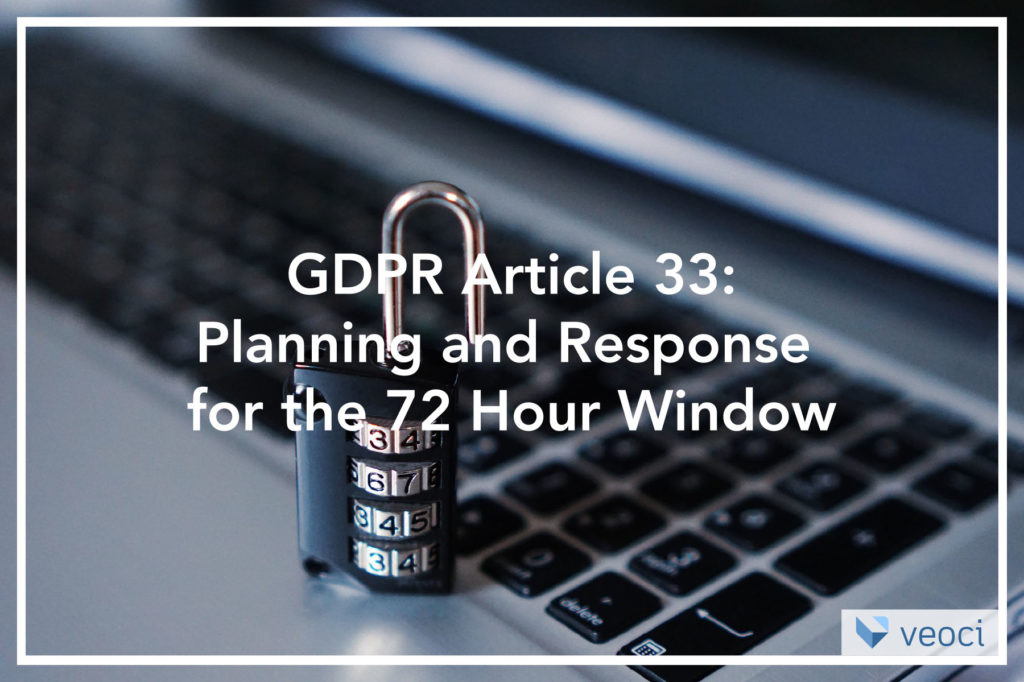Responding to a data breach is a high-pressure situation, especially when you consider the EU’s newest privacy regulation, the General Data Protection Regulation (GDPR), and its requirements. If you and your organization fall under the scope of the GDPR, you need to know what your obligations per the GDPR are.
Jennifer McTiernan, General Counsel at Veoci, and Nathaniel Ellis, Co-founder and Director of Strategic Solutions at Veoci, explored these topics in a recent webinar. In case you missed it, here’s a quick rundown of what they covered.
The GDPR basics
Businesses all over the world are still figuring out the GDPR. Certain pieces of it still need interpretation, There are some parts that still need interpretation, but you can get some of the basics here. Overall, the GDPR is an opportunity to raise the bar for data management practices on a global scale and to build more trust between data collectors and data subjects.
Data controllers, data processors, and data breaches
The GDPR establishes two important distinctions: data controllers and data processors.
Data controllers start the data collection process, and their responsibilities reflect this:
- Establishing the legal basis for collecting data
- Defining the use and purpose of the collected data
- Determining what data and whose data is collected
Data processors are much more hands-on with the data, and their responsibilities spell that out:
- Determining how personal data is stored
- Deciding which security practices are used to protect the stored data
- Determining how data is deleted, disposed of, or produced at the request of a data subject
Article 4 of the GDPR defines a data breach as “a breach of security leading to the accidental or unlawful destruction, loss, alteration, unauthorized disclosure of, or access to personal data transmitted, stored, or otherwise processed.” When a breach happens, each party has another set of obligations to meet.
A data processor must notify their data controller as soon as possible if they’re hit. But data controllers have to do much more, including:
- Notify their supervisory authority within 72 hours of discovery
- Describe the breach, the number of involved data subjects, and the compromised data
- Direct data subjects to where they can obtain more information
- List the likely consequences of the breach
- State the data controller’s plan for addressing the breach, as well as ways data subjects can mitigate the effects
- Document the event
Beating the 72 hour window
Communication is the key to complying with the GDPR’s 72 hour data breach reporting window. The Veoci team has already developed working breach response plans and solutions which can be launched with a mouse click or finger tap, with a clear focus on maintaining security, facilitating collaboration, and opening lines communication.
“Handling a highly sensitive and time-sensitive situation – this is not happening over email, this is happening in a secure environment”
When a plan is launched, notifications are immediately sent out and initial triage begins as team members quickly swap information. This continues as the breach response escalates with team members commenting in a Veoci room and its message threads. The conversation includes everyone, but remains organized and accessible.
This inclusivity comes with Veoci’s flexibility as a platform; the same flexibility also creates exclusivity when it’s necessary.
Side Rooms can be locked with access given only to specific stakeholders; for the GDPR response plan, Side Rooms can launched and used to protect sensitive information while keeping specific people informed.
Along with these communication capabilities and controls, Veoci also provides integrated process tools such as Checklists, Tasks, and Workflows, to round out the entire response. Workflows and tasks can push a response along the right steps as it escalates, based on established plans and current conditions.
At its heart, a data breach response process is about transparency, accountability, and speed. A
data breach response must have a documentation system with robust access controls so the right people can see the right reports; easily defined and assigned roles for maintaining accountability; and powerful communication tools to keep things moving at a rapid pace.
Hitting every mark
“Handling a highly sensitive and time-sensitive situation – this is not happening over email, this is happening in a secure environment,” says Jennifer McTiernan. What Veoci provides is a safe environment for sharing delicate information and resolving high-pressure situations, and it streamlines the process along the way. It’s the ideal platform for tackling any data breach response.








